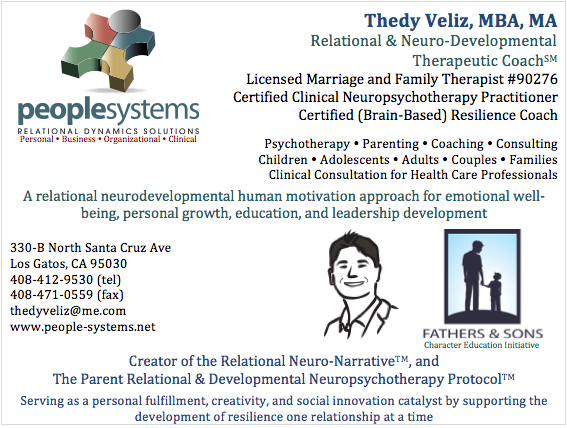People Systems: A Relational & Neuro-Developmental Approach to Human Dynamics
Through my multidisciplinary research, professional training, and clinical experience, I have developed the People Systems Relational & Neuro-Developmental Approach to Human Dynamics.
The basic features of the People Systems Approach are:
• The source of human suffering resides in early life conditions that are not conducive to the healthy development of the person’s neurobiological systems which are designed first and foremost to ensure safety and survival. Thus, high levels of stress during critical periods results in healthy development being compromised as the neurobiological systems become conditioned to react to a stressful environment by developing strategies to defend, avoid and protect against others which are ‘wired’ into the growing organism’s personality. All of this is not a cognitive, nor an emotional process, but rather a process that is more connected with visceral states – what Stephen Porges calls neuroception (Porges, 2011).
• Parents love their children, and will do whatever it takes to provide the best developmental experiences for them. However, parents are not immune to the effects of stress, and when we as adults are disregulated by stress, it is neurobiologically impossible to provide regulation for our children.
• Behavioral challenges are part of the developmental process as children and adolescents are limited by the lack of development of their prefrontal cortex. Thus, in most cases the symptoms that motivate parents to seek parenting support for their children are not only due to the disregulated behavior, but also to how parents respond to such disregulated behavior. And… In defense of parents, traditional parenting techniques do not take into account recent neurodevelopmental research findings pertaining to parenting and child development.

• As a society we exceed in cognitively driven technological advances, but lag when it comes to understanding the emotional dynamics that drive our behavior. Unless we make the effort to learn otherwise, we have a tendency to treat children as if they were 'little adults,' and we expect them to have self-regulation capabilities that are not possible due to their brain development limitations. This disconnect results in children feeling misunderstood by the caregivers in their lives, and these feelings are usually driving the behaviors that get children in trouble.
• A byproduct of our societal discomfort with emotional dynamics is our tendency to conduct our interactions with other people by using what I call a ‘transactional approach.’ It is this transactional approach which originates from our social constructs and history that gets in the way of us feeling connected with one another even though we so desperately want and need to.
• Improvement in the relational dynamics between two people regardless of the type of relationship requires a shift from a transactional to a more relational approach. This relational approach can only be learned from another human being – through experience. We are all capable of operating in a relational way, but due to the sociocultural dynamics of our society, this is something that requires active practice between two people.
• When people are experiencing emotional or relational challenges, healing requires for them (assuming there are no safety concerns) to improve their connections with the important people in their lives. I facilitate these important connections and while I develop a therapeutic relationship with the client, the ultimate purpose of this relationship is to serve as a model for the improvement of the client’s important relationships. This might seem trivial, but it is critical differentiator of the People Systems Approach.

• Since healing comes about from the improvement of the client’s relationships, while for legal purposes the client is the person or persons sitting in the therapist's office, their healing depends on treating the client’s relationships as the ‘therapeutic client.’
• Since people exhibit emotional and relational problems due to challenges with their significant relationships, my role is to facilitate the improvement of such relationships.
• This is why unless a child is exhibiting severe unhealthy and risky behavior, I highly recommend for the work to be done through the parents. It is my experience that parents are burdened by societal misconceptions about the neurobiology associated with their children’s symptoms, and once they understand what the symptoms communicate about the child’s internal world, they are able to make the changes needed to therapeutically respond to the child’s behavior.
• The same principle applies when working with adults. I work to as quickly as possible invite the people whom the client is having relational challenges with to participate in sessions even if the adult might have announced early on that the relationship is over. When the other party is in the room, we can now refer to feelings and emotions. If we are just reporting about what happened with someone that is not in the room, we all quickly go into our heads – into the cognitive transactional world. It is my experience that this cognitive transactional dynamics can easily work against our relationships.
References
- Porges, S. W. (2011). The Polyvagal Theory: Neurophysiological Foundations of Emotions, Attachment, Communication, and Self-regulation (Norton Series on Interpersonal Neurobiology). WW Norton & Company.
